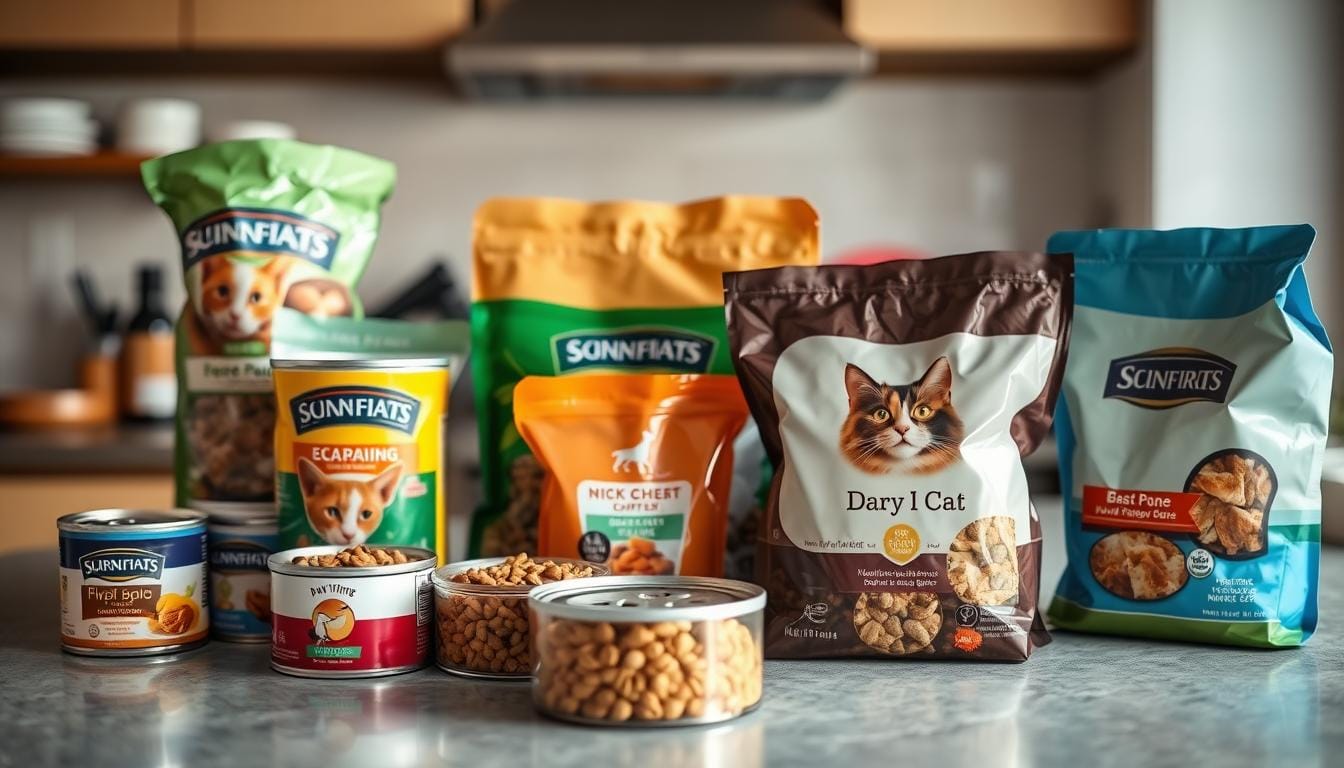
Table of Contents
Are you giving your cat the right food? The debate over wet and dry cat food has confused many pet owners. It’s important to understand what your cat needs to stay healthy and happy.
Vets say both wet and dry foods have their own benefits. What’s best for your cat depends on their age, weight, health, and how active they are. These factors help decide the best food for them.
This guide will help you understand cat food better. We’ll look at the good and bad of wet and dry food. This will help you choose the best food for your cat’s health. Whether you’re new to cat ownership or have been a pet parent for years, you’ll learn something new.
We want to give you the knowledge to make sure your cat gets the best nutrition. Let’s explore the world of cat food together and find the perfect diet for your cat.
Understanding Cat Food Basics
Caring for your cat’s nutritional needs is more than just filling their bowl. Cats are special and need a diet that’s different from other pets. They must eat high-quality protein to stay healthy and full of energy.
Commercial Cat Food Types
There are three main types of cat food:
- Dry Kibble: Easy to use and affordable
- Wet Canned Food: Has a lot of moisture
- Semi-Moist Options: A mix of dry and wet
Nutritional Requirements for Cats
Cats need certain nutrients that are specific to them. Protein is key, and amino acids like taurine are vital for their heart and eyes.
AAFCO Standards and Guidelines
The Association of American Feed Control Officials (AAFCO) sets important standards for pet food. Their rules make sure cat food has the right nutrients. Always check for AAFCO compliance on labels to ensure your cat gets a balanced diet.
“A balanced diet is the foundation of your cat’s health and longevity.” – Veterinary Nutrition Experts
The Great Debate: Wet vs Dry Cat Food
Choosing between wet and dry cat food is a big decision for cat owners. Each option has its own benefits and drawbacks. This leads to lively discussions among experts in pet nutrition.
The debate focuses on several key points. These points affect your cat’s health and happiness. Knowing these differences helps you choose the right food for your cat.
- Moisture content is important for food quality
- Nutritional density varies between wet and dry foods
- Palatability differs between food types
Veterinary nutritionists say each food type has its own benefits. Dry food is convenient and good for teeth. Wet food is better for hydration and protein. Your cat’s needs, age, and health determine the best food choice.
“No single food type is perfect for every cat. The key is understanding your pet’s unique nutritional requirements.” – Veterinary Nutrition Expert
When comparing cat diets, consider a few things:
- Your cat’s age and activity level
- Existing health conditions
- Hydration needs
- Budget and storage constraints
The debate over wet versus dry cat food keeps growing. New research sheds light on what’s best for cats. Your vet is the best person to help choose the right food for your cat.
Moisture Content: A Key Difference
Knowing about cat food moisture is key for your cat’s health. Cats don’t drink much water, so their food’s water content is very important. It affects their hydration and overall health.
Dry cat food has about 10% moisture, while wet food has 70-80%. This big difference affects your cat’s water levels a lot.
Water Content in Wet Food
Wet cat food is great for cats who don’t drink enough water. It has a lot of water, which helps:
- Kidney function
- Urinary tract health
- Digestive system performance
- Overall hydration levels
Hydration Benefits and Concerns
Cats come from desert ancestors and don’t feel thirsty often. This can cause mild dehydration if they only eat dry food. Wet food is key for keeping them hydrated.
Veterinarians often recommend incorporating wet food to support cats’ natural hydration needs.
Your cat’s health, age, and medical history affect their diet needs. Talking to a vet can help find the right balance of moisture for your cat.
Manufacturing Processes and Quality Control
Knowing how cat food is made is key for pet owners. They want to make sure their cats get the best nutrition. Wet and dry cat foods are made differently, affecting their nutrition and how long they last.
Pet food quality starts with the right ingredients and careful processing. Dry cat food is made by:
- Mixing raw ingredients
- Using high heat and pressure
- Shaping into kibble
- Drying and adding flavor enhancers
Wet cat food is made in a canning-like process. This helps keep nutrients and moisture in. The steps are:
- Blending meat, fish, or poultry
- Cooking at controlled temperatures
- Sterilizing sealed containers
- Keeping nutrients in
Quality control is very important in making cat food. Good manufacturers test their food a lot. They check:
- Where ingredients come from
- Nutritional content
- Microorganisms
- Contaminants
When picking cat food, choose brands that share how they make it. Your cat’s health is at stake.
Nutritional Composition Comparison
Knowing what’s in your cat’s food is key to their health. Cat food nutrients are vital for your pet’s well-being. Each food type has special nutrients that help in different ways.
Wet and dry cat foods have different nutritional benefits. It’s important to know what each offers to your cat’s diet.
Protein Levels: The Building Blocks of Feline Nutrition
Protein is essential in cat food. Cats need high-quality protein to keep their muscles strong and healthy. Wet and dry foods have different protein levels:
- Wet food typically contains 8-10% protein
- Dry food usually ranges from 10-12% protein
- Premium brands may offer even higher protein concentrations
Fat Content: Energy and Flavor
Fat is another important nutrient in cat food. It gives cats energy and makes their food taste better. Fat levels vary between food types:
- Wet food: Around 3-5% fat content
- Dry food: Typically 10-15% fat content
- Higher fat levels can support active cats
Carbohydrate Differences
Carbohydrates are another key difference in cat food. Dry foods have more carbs than wet foods:
- Wet food: Typically 1-2% carbohydrates
- Dry food: Often 30-40% carbohydrate content
- Lower carb options may benefit weight management
When picking cat food, think about your pet’s needs, activity level, and health. Talking to a vet can help you choose the best food for your cat.
Cost and Economic Considerations

When picking cat food, your budget is key. Knowing the price gap between wet and dry cat food helps you choose wisely. This way, you can find a balance between your cat’s needs and your wallet.
Prices for cat food vary a lot between wet and dry types. Dry cat food usually costs less, making it a better deal for many pet owners. Here are the main economic points:
- Dry cat food is often cheaper per serving
- Buying in bulk can lower your costs
- Dry food lasts longer, cutting down on waste
Dry cat food is usually cheaper by the pound than wet food. A 10-pound bag of dry food might cost $15-$25. But, the same amount of wet food could be $20-$40. This price gap is big if you have more than one cat or are watching your budget closely.
Here are some ways to save money:
- Buy more to get a better price per pound
- Watch for sales and use coupons
- Compare prices online and in stores
- Try store-brand options
Even though wet food is pricier, many owners mix it with dry food. This mix helps keep costs down while still giving your cat a varied diet.
Storage and Convenience Factors
Keeping your cat’s food fresh is key to their health and avoiding waste. Knowing how to store wet and dry cat food is important. It helps you choose the best food for your cat.
Dry and wet cat foods have different storage needs. This affects how long they stay good and safe for your cat to eat.
Shelf Life Differences
Dry cat food is easy to store. It can last 12-18 months if kept right. Wet cat food, however, has a shorter shelf life:
- Unopened wet food: Up to 2 years (if sealed)
- Opened wet food: 3-5 days refrigerated
- Dry food: Up to 6 months after opening
Proper Storage Methods
To keep your cat’s food fresh, follow these tips:
- Keep dry food in its original bag or airtight containers
- Store it in a cool, dry spot, away from sunlight
- Refrigerate opened wet food in sealed containers
- Use clean utensils to serve food to avoid contamination
“Proper storage is the key to maintaining your cat’s food quality and nutritional value.” – Veterinary Nutrition Expert
| Food Type | Storage Location | Maximum Storage Time |
|---|---|---|
| Dry Cat Food | Pantry/Cool Cupboard | 6 months after opening |
| Wet Cat Food (Unopened) | Pantry | 2 years |
| Wet Cat Food (Opened) | Refrigerator | 3-5 days |
Pro tip: Always check expiration dates and monitor your cat’s food for any signs of spoilage, such as unusual odors or discoloration.
Health Benefits of Wet Cat Food
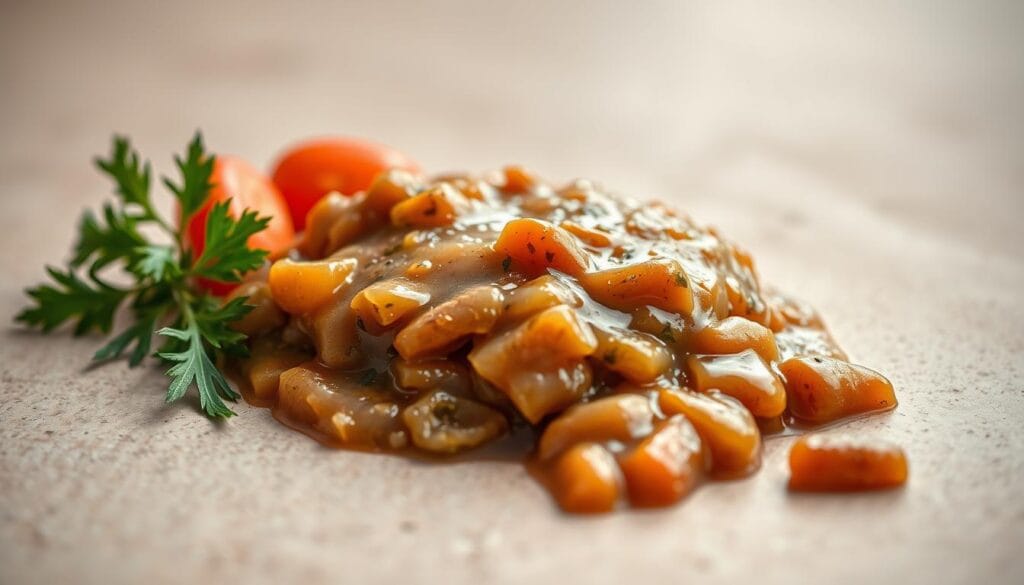
Canned cat food has many health benefits for your feline friend. It has a lot of moisture, which is great for cats with urinary tract problems. This helps keep them hydrated.
Vets often suggest wet food for cats with certain health issues. It’s not just about food; it helps with several health problems:
- Improved urinary tract health
- Better management of diabetes
- Support for kidney function
- Enhanced digestive performance
Cats with chronic kidney disease really benefit from canned cat food. It keeps them hydrated, which is key for cats who don’t drink enough water.
Wet food also helps with weight management. It has more protein and less carbs, helping cats stay at a healthy weight. Unlike dry food, wet food is closer to what cats naturally eat.
Proper nutrition is the foundation of feline health, and wet food can be a powerful tool in supporting your cat’s well-being.
For cats with sensitive stomachs, wet food is a better choice. Its soft texture and high moisture make digestion easier, reducing stomach upset.
Advantages of Dry Cat Food
Dry cat food, or kibble, is great for pet owners looking for easy and healthy meals for their cats. It’s more than just a convenient way to feed your cat.
One big plus of dry food is how affordable it is. It’s cheaper than wet food, making it a smart choice for cat owners. You can buy more for less money, which is good for families with many cats.
- Long shelf life without refrigeration
- Easy to measure and portion
- Convenient storage options
- Lower cost per serving
Dry cat food is also packed with nutrients. It has concentrated vitamins and minerals that keep your cat healthy. The crunchy texture can even help clean your cat’s teeth.
“Dry food provides a practical and nutritionally complete meal option for adult cats.” – Veterinary Nutrition Experts
When picking dry cat food, choose high-quality brands that follow AAFCO standards. These foods ensure your cat gets all the nutrients they need, like proteins and vitamins.
Every cat is different, so what’s best for them depends on their needs. Talking to your vet can help you find the right kibble for your cat.
Impact on Dental Health
Cat dental care is key to your cat’s health. Knowing how diet affects oral hygiene helps you choose the right food. This can prevent dental issues.
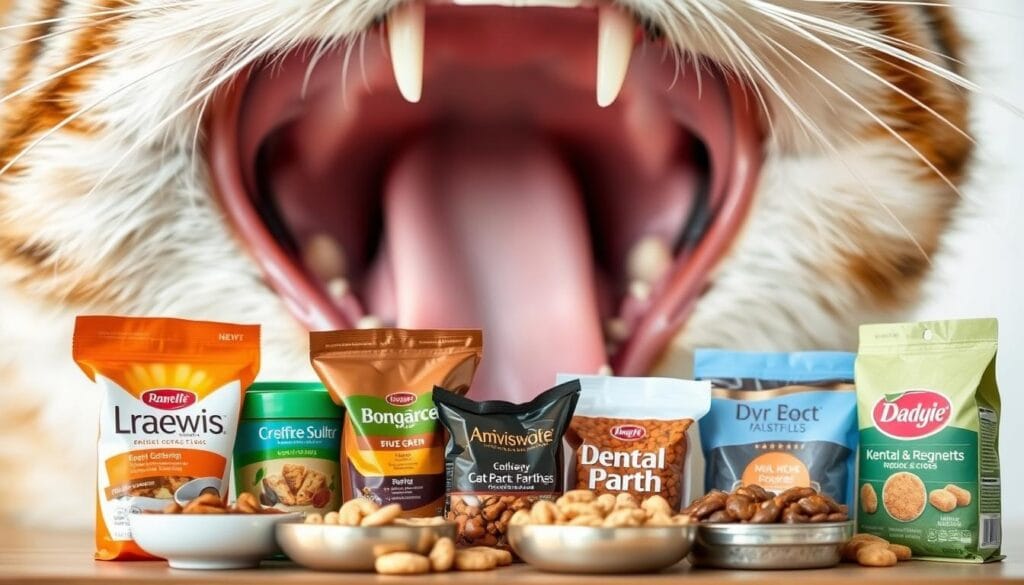
Your cat’s diet affects their dental health. Different foods have different effects, offering benefits and challenges.
Dental Benefits of Dry Food
Dry cat food has several dental benefits:
- Mechanical action removes tartar
- Crunchy texture cleans teeth naturally
- Chewing resistance reduces plaque
Dental Concerns with Wet Food
Wet food can be a challenge for dental care:
- Softer texture doesn’t clean teeth
- Food particles stick to teeth
- Bacterial growth is a risk
To keep your cat’s teeth healthy, try these:
- Regular dental check-ups
- Dental cat food
- Brush your cat’s teeth
- Use dental treats
| Food Type | Dental Impact | Recommended Frequency |
|---|---|---|
| Dry Food | Moderate Cleaning Action | Daily |
| Wet Food | Limited Cleaning Action | Supplemental |
| Dental Treats | Enhanced Cleaning | 2-3 Times Weekly |
Professional veterinary guidance is crucial for tailored dental care advice.
Weight Management Considerations
Keeping your cat at a healthy weight is vital for their health and long life. To prevent cat obesity, you need a smart plan for their diet and nutrition. The type of cat food you choose is very important for controlling their weight.
Wet food is often better for weight management because it has fewer calories. This makes it easier to control how much your cat eats. Wet food helps cats feel full with less food, which helps them stay at a healthy weight.
- Wet food typically contains fewer calories per serving
- Easier to measure precise portions
- Supports better hydration
- Can help prevent overeating
Dry food can be harder to manage for weight control. Free-feeding dry kibble can lead to eating too much. Cats might eat more calories than they need if food is always available. To avoid obesity, try these tips:
- Measure food portions carefully
- Use scheduled feeding times
- Choose low-calorie dry food options
- Combine wet and dry foods strategically
Every cat is different, so talking to a vet is a good idea. Regular checks and adjusting their diet are crucial for keeping your cat at a healthy weight.
Special Dietary Needs and Medical Conditions
When your cat has special health needs, finding the right diet is key. Vets often suggest diets that match your cat’s health issues. This helps keep them healthy and happy.
Each medical condition needs a special diet. Here are some examples:
- Kidney Disease: Wet foods help keep your cat hydrated
- Diabetes: Foods low in carbs help control blood sugar
- Food Allergies: Special diets with fewer ingredients can help
- Weight Management: Diets with fewer calories are needed
Your vet is essential in picking the right diet for your cat. They can choose from wet or dry foods to meet your cat’s needs.
| Medical Condition | Recommended Food Type | Key Nutritional Focus |
|---|---|---|
| Kidney Disease | Wet Food | Low Phosphorus, High Moisture |
| Diabetes | Low Carb Diet | Protein-Rich, Controlled Carbohydrates |
| Food Allergies | Limited Ingredient | Hypoallergenic Protein Sources |
Always talk to a vet to create a diet plan that fits your cat’s health needs.
Mixing Wet and Dry Foods: A Balanced Approach
Creating a balanced diet for your cat is important. Veterinarians suggest mixing wet and dry foods. This mix helps support your cat’s health.
The benefits of a mixed feeding approach include:
- Enhanced moisture intake from wet food
- Dental health maintenance through dry kibble
- Increased nutrient variety
- Improved palatability for picky eaters
Start by slowly adding new foods to your cat’s diet. A good starting ratio is:
| Cat Age | Wet Food (%) | Dry Food (%) |
|---|---|---|
| Kitten | 70 | 30 |
| Adult | 50 | 50 |
| Senior | 60 | 40 |
Watch your cat’s weight, energy, and health when changing their diet. Consult with your veterinarian to customize the perfect balanced feline nutrition plan for your unique cat.
“Variety is the spice of life, even for cats!” – Veterinary Nutrition Expert
Conclusion
Choosing the right food for your cat is very important. Each cat is different, needing food that matches their age, health, and likes. The debate over wet and dry food is ongoing, but what matters most is finding food that makes your cat happy and healthy.
Vets say it’s best to pick food based on your cat’s needs. Consider their health, lifestyle, and how they feel. Some cats do well with a mix of wet and dry food, getting all the nutrients they need.
As your cat grows older or gets sick, their diet might need to change. Regular vet visits and watching your cat’s health are key. This way, you can adjust their food to keep them in top shape.
The ideal cat food makes your cat lively, happy, and healthy. Learn what your cat needs and try different foods to find the best one. This way, you’ll ensure your cat stays in great condition.
FAQ
What are the main differences between wet and dry cat food?
Wet and dry cat food differ mainly in moisture content and nutritional density. Wet food has more moisture, which is good for cats with urinary issues. Dry food is more convenient and might help with dental health.
How much moisture do cats need in their diet?
Cats need about 70-80% moisture in their diet. Wet food has 70-80% water, while dry food has only 10%. This makes wet food great for keeping cats hydrated.
Is dry food bad for my cat’s health?
Dry food isn’t bad if chosen wisely and balanced with other nutrients. It offers dental benefits and is cost-effective. But, pick high-quality brands that meet AAFCO standards and consider adding extra moisture.
Can I mix wet and dry cat food?
Yes, mixing wet and dry food is a good way to balance nutrition. It combines the benefits of both, offering varied textures and moisture levels. Talk to your vet to find the right mix for your cat.
How do I choose the right cat food?
Consider your cat’s age, weight, health, and nutritional needs. Read AAFCO labels and check the protein content. Choose foods that are complete and balanced for your cat’s life stage.
Does wet food help with weight management?
Wet food can help with weight management. It’s more filling and has fewer calories than dry food. This makes it easier to control your cat’s calorie intake.
How long can wet cat food be left out?
Don’t leave wet cat food out for more than 1-2 hours. Bacteria can grow fast, causing illness. Always refrigerate leftovers and follow storage guidelines for safety.
Are there specific health conditions that require special dietary considerations?
Yes, conditions like kidney disease and diabetes need special diets. Cats with these issues might do better on specific wet or dry foods. Always get dietary advice from a vet.
What should I look for on cat food labels?
Look for AAFCO statements and check the guaranteed analysis. Prioritize high-quality protein sources in the ingredient list. Make sure the food meets your cat’s life stage needs.
How often should I change my cat’s diet?
Change your cat’s diet slowly, over 7-10 days. This prevents digestive upset. Watch for any negative reactions and consult your vet. Regular check-ups ensure your cat’s diet is still right.



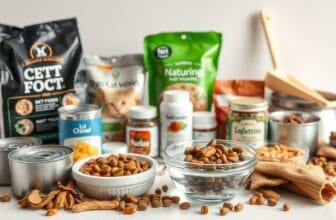
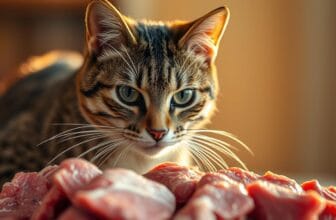
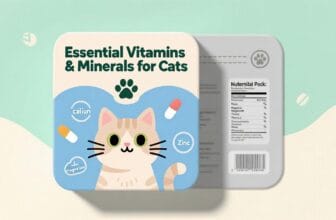
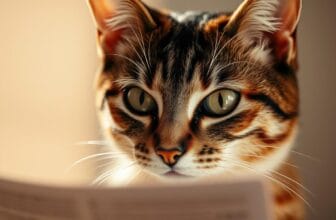

[…] the right amount of wet and dry cat food is key to your cat’s health. The moisture and nutrients in each type change how much you […]
[…] Dry cat food: 10% moisture […]